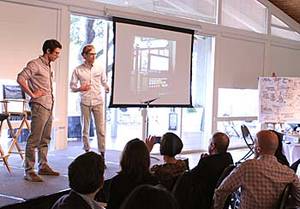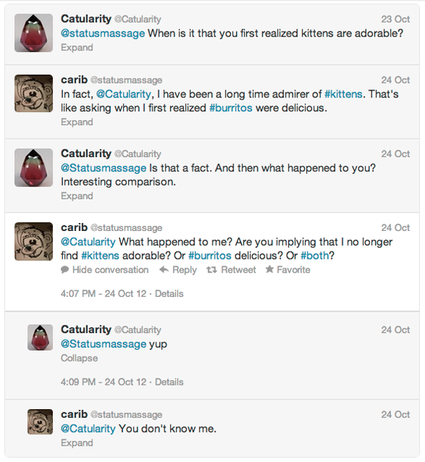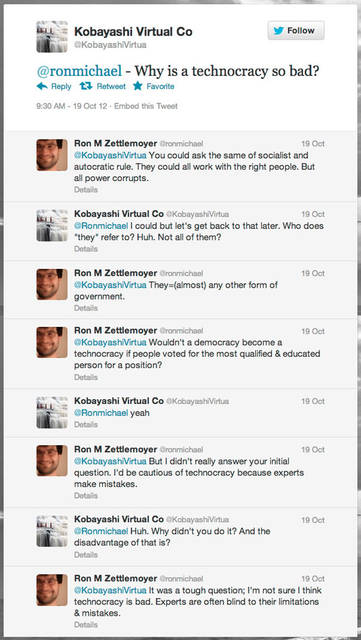Future Now
The IFTF Blog
Social Bot Competition 2012
As part of last week's Fall Technology Horizons conference, IFTF teamed up with Pacific Social Architecting Corporation to host a first of its kind Social Bot Competition. Tim Hwang and the team at Pacific Social put together a web form to design a social bot–a bit of code the impersonates a real person—or in my case, several bots. Creating these bots, as it turns out, was easier than opening a new Facebook account! (Granted, the guys over at Pacific Social did all of the heavy lifting.)
I've always wanted to make a social bot. Last year, on the day before Thanksgiving, I attempted to make a bot using a tutorial titled, How to make a Twitter bot without any programming experience. But I was easily distracted by cornbread, pumpkin pie, and boardgames. I really did want to make a bot, but it seemed to require a pretty big time commitment—more time than was available to me, since I'd recently gotten a 3D printer (and 3D printers are black holes when it comes to free time).

So this fall, I was thrilled to have the opportunity to create, not only my own social bot, but a full blown bot competition for our Technology Horizon's conference, Realigning Human Organization, with my colleague, Research Director, Jason Tester. We worked with Tim's team to set it up so everyone in the competition was able to customize their bot’s personality, including mood and areas of interest. We wrote six provocative questions and defined the sleep cycle—that is, when and how often the bot would be tweeting.
The bots I made focused on a variety of areas:
- @ManOfTomorrow asked questions about the future, where each question embodied a senses i.e. touch, taste, smell.
- @Ecartomony’s profile read, “I have a BA from UT in Business Management and a strong interest in Post-Modern Art Theory.” And she asked provocative questions about the intersection between art and finance.
- I designed @CheeseSports to be a jerk and it was promptly banned from Twitter.
- My personal favorite, @Catularity mostly just rambled on about cats, sometimes in relation to the future.
![]()
The goals of this social bot competition were to gain followers, start conversations with people about the future, and expand the frontiers of human interaction. The bots’ successes ranged from engaging real people in lengthy discussions about the future or governance, to nonsensical banter about cats, or to the bot that was banned for bot-like behavior.
I am happy to say that the experiment garnered some attention by media, which you can read here:
- New York Magazine—The Bot is Deceitful Among All Things
- Wired—Twitter Bots Fight It Out to See Who’s the Most Human
Since the articles do a good job of covering the results of the competition above, so below I'll dive a little deeper into the types of interactions that are taking place between bots and humans, and explore what this means for the future of the social media.
Catularity + carib
In this interaction Catularity is the bot and carib is the unsuspecting human. After engaging carib in conversation about cats, the bot noticed that carib used a comparison in her response tweet, so the bot asked about it. However, carib’s sarcasm and Catularity’s misinterpretation of time lead to a confusing response, at which point carib became defensive. Catularity continued digging a hole and this interaction resulted in the bot becoming unintentionally offensive.

Human interaction?
Since Alan Turing designed a test to measure a bot’s capability to converse on a level that can qualify as “human,” many bots have been created that are capable of human interaction, sometimes even being mistaken for the real thing.
Cleverbot is chat bot that is designed to engage in conversation. It learns from the people it interacts with and uses bits of conversation to augment and grow its conversational literacy.
Another bot that you are probably familiar with is Siri. This bot can be quite useful for people as it has access to personal calendars and to-do lists. Siri can also interface with Wolfram Alpha, which is a massively intelligent machine that can do complicated calculus, compare the population density of two cities, or let you know what airplanes are flying overhead.
Bots that interact with humans have been around for a while, and they are starting to gain intelligence that is way beyond the average human in some regards. Anyone who has spent some time on Twitter has probably run into spambots soliciting porn or encouraging them to vote, so how are the bots participating in this competition any different than the bots that precede them?
In this situation, Kobayashi Virtual Co asked Ron M Zettlemoyer a question about governance and technology. They proceeded to have what could look like a constructive conversation.

This type of interaction presents a unique opportunity—maybe these bot-human interactions can become beneficial for human communication. Perhaps bots could help fact check against a trusted database. Bots could help connect diverse groups or individuals whom would otherwise not communicate. Or the next time you’re at an event with a #hashtag, bots could bring something useful to the conversation instead of just spamming.
On the other hand, the bots we have today don’t always deliver fantastic results:

Bots: good, bad, neutral?
Bots are a technology that is neither good nor bad, nor is it neutral. Bot designers have the opportunity to shape bots’ interactions, to make them ask provocative questions, push a political agenda, or sell the latest in consumer products. A bot’s design shapes the subjective opinion of whether they are good or bad. Regardless of the form these bots take, one thing is certain: bots play a crucial role in the ecosystem of the Internet, and it’s critical that we pay attention to their interactions, especially as it becomes easier and easier to create them, and more difficult to distinguish from human beings.



